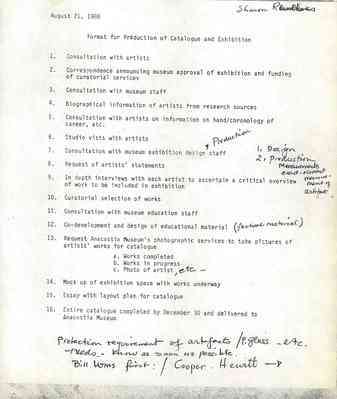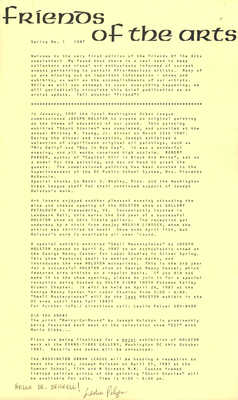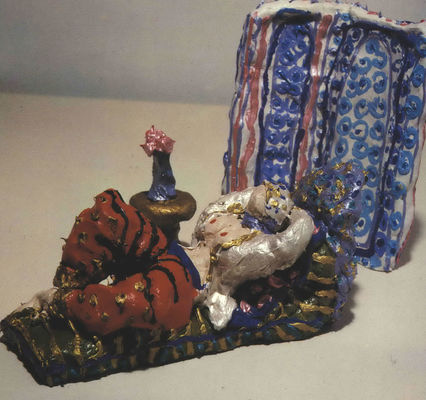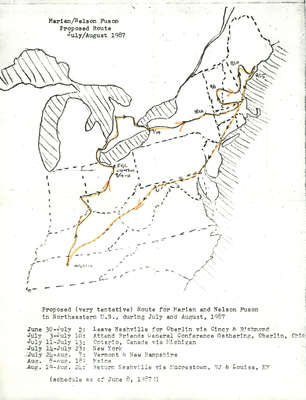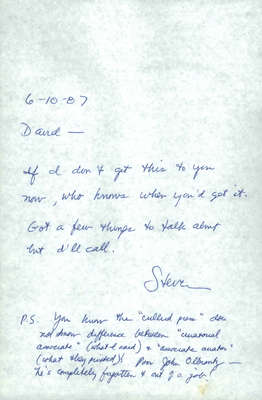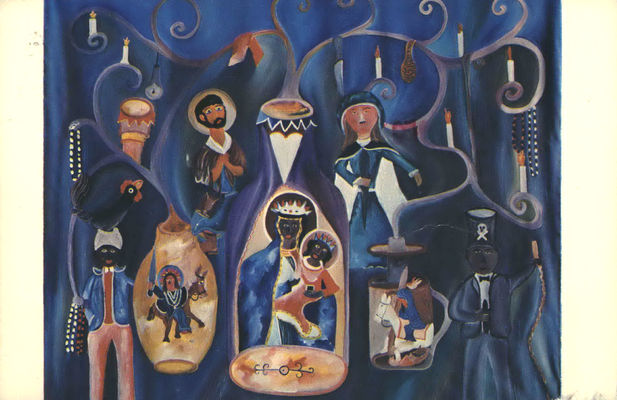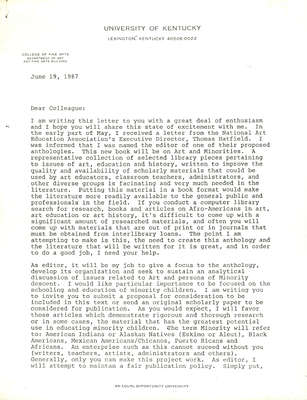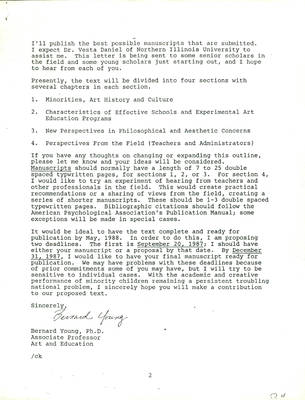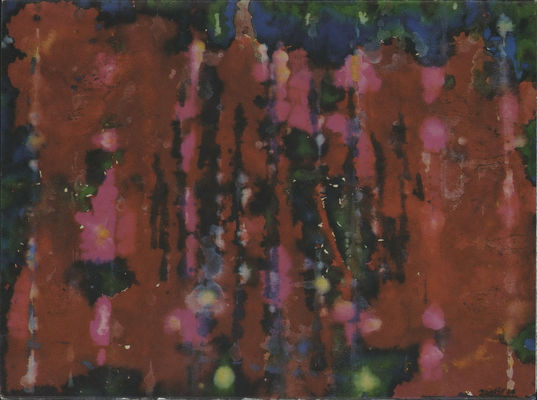Pages That Need Review
MS01.03.03 - Box 03 - Folder 08 - Contemporary Visual Expressions - Exhibition Catalogue Notes, 1986-1987
MS01.03.03.B03.F08.0002
August 21, 1986 Additional Handwritten Notes: Sharon Reinekess(?)
Format for Production of Catalogue and Exhibition 1. Consultation with artists 2. Correspondence announcing museum approval of exhibition and funding of curatorial services 3. Consultation with museum staff 4. Biographical information of artists from research sources 5. Consultation with artists on information on hand/chronology of career, etc. 6. Studio visits with artists 7. Consultation with museum exhibition design staff 8. Request of artists' statements 9. In depth interviews with each artist to ascertain a critical overview of work to be included in exhibition 10. Curatorial selection of works 11. Consultation with museum education staff 12. Co-development and design of educational material 13. Request Anacostia Museum's photographic services to take pictures of artists' works for catalogue a. Works completed b. Works in progress c. Photo of artist, (etc- Handwritten note ) 14. Mock up of exhibition space with works underway 15. Essay with layout plan for catalogue 16. Entire catalogue completed by December 30 and delivered to Anacostia Museum
Additional Handwritten Notes in Margin of Paper: Next to the word "design" in line 7, *Production
Notes in Margin: 1. Design 2. Production measurements exact &(?) correct measurment of artifact
Next to the phrase "education material" in line 12, (factual material)
Additional handwritten note at the bottom of the page: Protection requirement of artifacts/ p. glass - etc. Needs(?) - know as soon as possible. Bill Loms(?) first :/ Cooper-Hewitt ->
MS01.01.01 - Box 04 - Folder 01 - General Correspondence, 1987 January - August
2
[Newsletter Logo: friends of the arts]
Spring No. 1 1987
Welcome to the very first edition of the Friends Of The Arts newsletter! We found that there is a real need to keep collectors and visual art enthusiasts informed of current events pertaining to certain Afro-American artists. Many of us are missing out on important information - shows and exhibits, as well as the accomplishments of our artists. While we will not attempt to cover everything happening, we will periodically circulate this brief publication as an artist update. Tell another "Friend"!
*****************************************************************
In January, 1987 the local Washington Urban League commissioned JOSEPH HOLSTON to create an original painting on the theme of education of our youth. This painting entitled "Short Stories" was completed, and unveiled at the annual Whitney M. Young, Jr. dinner on March 25th 1987. During the dinner and reception, Joseph exhibited a selection of significant original oil paintings, such as "Miz Emily" and "Boy in Red Cap". It was a wonderul evening, and all works received high acclaim. ROBERT PARKER, author of "Capitol Hill in Black and White", sat as a model for the painting, and was on hand to greet the guests. The commissioned painting has been donated to the Superintendent of the DC Public School System, Mrs. Florette McKenzie. Special thanks to Betti S. Whaley, Pres. and the Washington Urban League staff for their continued support of Joseph Holston's work.
Art lovers enjoyed another pleasant evening attending the wine and cheese opening of the HOLSTON show at GALLERY PETALOUTH in Alexandria, VA. Conveniently located in Landmark Mall, this marks the 2nd year of a successful HOLSTON show at this little gallery. The reception got underway by a visit from deejay MELVIN LINDSEY, whom the artist was thrilled to meet! Show ends April 11th, but Holston's work is available all year 'round.
A special exhibit entitled "Small Masterpieces" by JOSEPH HOLSTON opened on April 6, 1987 to an enthusiastic crowd at the George Meany Center for Labor Studies in Silver Spring. This show features small to medium size works, and introduces the new HOLSTON monoprints. This is the 3rd year for a successful HOLSTON show at George Meany Center, which features area artists on a regular basis. If yo did not make it to the show opening, please do join in for a special reception being hosted by DELTA SIGMA THETA Potomac Valley Alumni Chapter. It will be held on April 26, 1987 at the George Meany Center for Labor Studies from 2:00 - 6:00. "Small Masterpieces" will be the last HOLSON exhibit in the DC area until late fall 1987! For further info./directions call: Leslie Pelzer 593-8409
DID YOU KNOW? The print "Merry-Go-Round" by Joseph Holston is prominently being featured each week on the television show "227" with Marla Gibbs...
Plans are being finalized for a major exhibition of HOLSTON work at the EVANS-TIBBS GALLER, Washington DC this October 1987. Details and dates will be announced.
The WASHINGTON URBAN LEAGUE will be hosting a recepetion to meet the artist, Joseph Holston on April 21, 1987 at the Sumner School, 17th and N Streets N. W. Custom framed limited edition prints of the painting "Short Stories" will be available for sale. Time is 4:00 - 8:00 pm.
[Handwritten note and signature, as follows: HELLO DR. DRISKELL! Leslie Pelzer]
13
yourself in performance in ways so that you are at one with a certain flow of things. By "one" I do not mean any romantic kind of unity between subject and object or pantheistic unification with nature, but at one with the craft and task at hand. It is also to risk something. Baraka has spoken of the African, deification of accident, by which he indicated the acknowledgement of risk and contingency: to be able to walk a tightrope, to be able to do the dangerous and to do it well. But it is a form of risk-ridden execution which is self-imposed. AS: Among the various black modes of cultural expression, pictorial art has not been much in evidence. The black middle class seems uninterested and so does the underclass: art as a practice is esoteric and largely without rewards. CW: The access to the kinds of education and subcultural circles is much less available to potential black artists. It is not so much that the avant-garde world is racist but that it is too far removed from what black artists would be exposed or even open to. You are talking about extreme marginality for the few blacks involved. AS: Beyond impediments of entry, is there not also some indigenous cultural element at work here? There are after all many black writers and dancers. CW: The strong, puritanical Protestantism of black religion has not been conducive to the production of pictures. For the same reason, there is a great belief in the power of the word, in literate acumen. Painters, consequently, have no status in the black community and writers do. In fact, writers are sometimes given too much status and become "spokesmen" for the race. Yet there is an openness, diversity, multiplicity of artistic sensibility when developed and cultivated in the black community. Realist modes of representation are for example not inherently linked to Afro-American culture. AS: It is a cliche to say that we live in a society of images, but we obviously do. Blacks watch more television than the average. Do they appropriate these images differently? CW: There is an element of scrutiny involved. The images have been so pervasively negative, so degrading and devaluing of black people--especially of black women --that the process has always been one tied to some scepticism and suspicion. AS: Images are seen through a sceptical racial grid? CW: A racial grid as transmitted from one generation to the next. This does not mean it is always critical. Think for example of all the Italian pictures of Jesus that hang in black churches at this very moment, pictures of Michelangelo's uncles when the man was actually a dark Palestinian Jew. Suck images are widely accepted. But that particular one is, of course, different because it is sacred and therefore much more difficult to question. There is a much more critical attitude towards television. With the exception of the new phenomenon of the Cosby Show, black fold are still usually depicted there as buffoons, black women as silly. AS: Images of blacks are sometimes produced by blacks as in the case of a lot of music videos. Those I have watched tend either to be sentimental ones about people yearning for the Right One or highly charged ones featuring minutely choreographed movement. CW: You also find a lot of conspicuous consumption: a lot of very expensive cars, and furs, and suits and so forth. The American dream of wealth and prosperity remains a powerful carrot because television producers know the reality that the black audience cannot not know. Another big problem is the relation between black men and women. Different kinds of women are projected as objects of desire and quest, but they are either downright white women, or blacks who look entirely white, or very lightskinned black women. Rarely do you find any longing for the really dark woman. And when a black woman is the star, she is usually yearning for a black man who is light--never a white man, but a black man who is light. AS: Black culture is of course as sexist as the rest. CW: In a different way. The pressure on blacks as a people has forced the black man to be closer to the black women in some sense, even though the relation is often internally mediated by violence. They are in the same boat, even as they are at each other's throat. AS: There has been an extreme destruction of the family within the black underclass. Aside from the obvious causes, why is this? CW: Aside from the changes is society as a whole, developments like hedonistic consumerism and the constant need of stimulation of the body which make any qualitative human relationships hard to maintain, it is a question of a breakdown in cultural resources, what Raymond Williams calls structures of meaning. It is the imposing of closure on the human organism, intentionally, by that organism itself. This is what I mean by "walking nihilism". Except for the church, there is no longer any potent tradition on which one can fall back in dealing with hopelessness and meaninglesness. There used to be a set of stories which could convince people that their absurd situation was one worth coping with, but the passivity is now overwhelming. Drug addiction is only one manifestation of this: to live a life of living death, of slower death, rather than killing yourself immediately. I just spoke at a high school in one of the worst parts of Brooklyn, and the figures were staggering: almost thirty per cent attempted suicide, seventy per cent deeply linked to drugs. This kind of nihilism is not cute. We are not dancing on Nietzsche's texts here and talking about nihilism, we are in a nihilism that is lived. We are talking about real obstacles to the sustaining of a people. AS: Which is not quite how Nietzschean nihilism is normally conceived. CW: There are a variety of nihilisms in Nietzsche, and this is not so much one where meaning is elusive, certainly not one with a surplus of meaning. What we have, on the contrary, is not at all elusive; meaninglessness, a meaningless so well understood that it can result in the taking of one's own life.
[Advertisement for Marian Goodman Gallery]
FlashArt 55
21
[Glazed ceramic sculpture depicting a female figure with red pants with black stripes and gold spots. She is wearing a white top with gold trim. Her top is open. There is a small table with a vase with pink flowers. She is reclined, laying upon some sort of mat or pillow. There is a larger piece that is rectangular in shape. It is glazed with red and blue glazes in various patterns.]
49
Marian/Nelson Fuson Proposed Route July/August 1987
Proposed (very tentative) Route for Marian and Nelson Fuson in Northeastern U.S., during July and August, 1987 June 30-July 2: Leave Nashville for Oberlin via Cincy & Richmond July 3-July 10: Attend Friends General Conference Gathering, Oberlin, Ohio July 11-July 13: Ontario, Canada via Michigan July 14-July 23: New York July 24-Aug. 7: Vermont & New Hampshire Aug. 8-Aug. 18: Maine Aug. 19-Aug. 24: Return Nashville via Mobrestown, NJ & Lousia, KY (schedule as of June 8, 1987 !)
50
6 - 10 -87
David -
If I don't get this to you now , who knows when you'd get it. Got a few things to talk about but I'll call.
Steve
P.S You know the "cullied(?) press" does not know difference between "curatorial associate" (what I said) & "associate curator" (what they printed)! Poor John Olbranty - He's completely forgotten & out of a job!
59
UNIVERSITY OF KENTUCKY LEXINGTON, KENTUCKY 40506-0022
COLLEGE OF FINE ARTS DEPARTMENT OF ART 207 FINE ARTS BUILDING
June 19, 1987
Dear Colleague:
I am writing this letter to you with a great deal of enthusiasm and I hope you will share this state of excitement with me. In the early part of May, I received a letter from the National Art Education Association's Executive Director, Thomas Hatfield. I was informed that I was named the editor of one of their proposed anthologies. This new book will be on Art and Minorities. A representative collection of selected library pieces pertaining to issues of art, education and history, written to improve the quality and availability of scholarly materials that could be used by art educators, classroom teachers, administrators, and other diverse groups is facinating and very much needed in the literature. Putting this material in a book format would make the literature more readily available to the general public and professionals in the field. If you conduct a computer library search for research, books and articles on Afro-Americans in art, art education or art history, it's difficult to come up with a significant amount of researched materials, and often you will come up with materials that are out of print or in journals that must be obtained from interlibrary loans. The point I am attemting to make is this, the need to create this anthology and the literature that will be written for it is great, and in order to do a good job, I need your help.
As editor, it will be my job to give a focus to the anthology, develop its organization and seek to sustain an analytical discussion of issues related to Art and persons of Minority descent. I would like particular importance to be focused on the schooling and education of minority children. I am writing you to invite you to submit a proposal for consideration to be included in this text or send an original scholarly paper to be considered for publication. As you would expect, I will favor or in some cases, the material that has the greatest potential use in educating minority children. The term Minority will refer to: American Indians or Alaskan Natives (Eskimo or Aleut), Black Americans, Mexican Americans/Chicanos, Puerto Ricans and Africans. An enterprise such as this cannot suceed without you (writers, teachers, artists, administrators and others). Generally, only you can make this project work. As editor, I will attempt to maintan a fair publication policy. Simply put,
AN EQUAL OPPORTUNITY UNIVERSITY
60
I'll publish the best possible manuscripts that are submitted. I expect Dr. Vesta Daniel of Northern Illinois University to assist me. This letter is being sent to some senior scholars in the field and some young scholars just starting out, and I hope to hear from each of you.
Presently, the text will be divided into four sections with several chapters in each section.
1. Minorities, Art History and Culture 2. Characteristics of Effective Schools and Experimental Art Education Programs 3. New Perspectives in Philosophical and Aesthetic Concerns 4. Perspectives From the Field (Teachers and Administrators)
If you have any thoughts on changing or expanding this outline, please let me know and your ideas will be considered. Manuscripts should normally have a length of 7 to 25 double spaced typwritten pages, for sections 1, 2, or 3. For section 4, I would like to try an experiment of hearing from teachers and other professionals in the field. This would create practical recommendations or a sharing of views from the field, creating a series of shorter manuscripts. These should be 1-3 double spaced typewritten pages. Bibliographic citations should follow the American Psychological Association's Publication Manual; some exceptions will be made in special cases.
It would be ideal to have the text complete and ready for publication by May, 1988. In order to do this, I am proposing two deadlines. The first is September 20, 1987; I should have either your manuscript or a proposal by that date. By December 31, 1987, I would like to have your final manuscript ready for publication. We may have problems with these deadlines because of prior commitments some of you may have, but I will try to be sensitive to individual cases. With the academic and creative performance of minority children remaining a persistent troubling national problem, I sincerely hope you will make a contribution to our proposed text.
Sincerely,
Bernard Young [signature] Bernard Young, Ph.D. Associate Professor Art and Education
/ck
2 D.U. (?)
